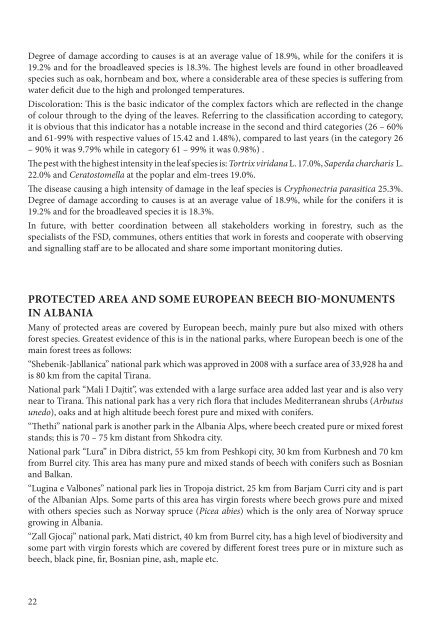You also want an ePaper? Increase the reach of your titles
YUMPU automatically turns print PDFs into web optimized ePapers that Google loves.
Degree of damage according to causes is at an average value of 18.9%, while for the conifers it is<br />
19.2% and for the broadleaved species is 18.3%. The highest levels are found in other broadleaved<br />
species such as oak, hornbeam and box, where a consi<strong>de</strong>rable area of these species is suffering from<br />
water <strong>de</strong>ficit due to the high and prolonged temperatures.<br />
Discoloration: This is the basic indicator of the complex factors which are reflected in the change<br />
of colour through to the dying of the leaves. Referring to the classification according to category,<br />
it is obvious that this indicator has a notable increase in the second and third categories (26 – 60%<br />
and 61-99% with respective values of 15.42 and 1.48%), compared to last years (in the category 26<br />
– 90% it was 9. 9% while in category 61 – 99% it was 0.98%) .<br />
The pest with the highest intensity in the leaf species is: Tortrix viridana L. 1 .0%, Saperda charcharis L.<br />
22.0% and Ceratostomella at the poplar and elm-trees 19.0%.<br />
The disease causing a high intensity of damage in the leaf species is Cryphonectria parasitica 25.3%.<br />
Degree of damage according to causes is at an average value of 18.9%, while for the conifers it is<br />
19.2% and for the broadleaved species it is 18.3%.<br />
In future, with better coordination between all stakehol<strong>de</strong>rs working in forestry, such as the<br />
specialists of the FSD, communes, others entities that work in forests and cooperate with observing<br />
and signalling staff are to be allocated and share some important monitoring duties.<br />
ProTecTed area aNd some euroPeaN beech bIo-moNumeNTs<br />
IN aLbaNIa<br />
Many of protected areas are covered by European beech, mainly pure but also mixed with others<br />
forest species. Greatest evi<strong>de</strong>nce of this is in the national parks, where European beech is one of the<br />
main forest trees as follows:<br />
“Shebenik-Jabllanica” national park which was approved in 2008 with a surface area of 33,928 ha and<br />
is 80 km from the capital Tirana.<br />
National park “Mali I Dajtit”, was exten<strong>de</strong>d with a large surface area ad<strong>de</strong>d last year and is also very<br />
near to Tirana. This national park has a very rich flora that inclu<strong>de</strong>s Mediterranean shrubs (Arbutus<br />
unedo), oaks and at high altitu<strong>de</strong> beech forest pure and mixed with conifers.<br />
“Thethi” national park is another park in the Albania Alps, where beech created pure or mixed forest<br />
stands; this is 0 – 5 km distant from Shkodra city.<br />
National park “Lura” in Dibra district, 55 km from Peshkopi city, 30 km from Kurbnesh and 0 km<br />
from Burrel city. This area has many pure and mixed stands of beech with conifers such as Bosnian<br />
and Balkan.<br />
“Lugina e Valbones” national park lies in Tropoja district, 25 km from Barjam Curri city and is part<br />
of the Albanian Alps. Some parts of this area has virgin forests where beech grows pure and mixed<br />
with others species such as Norway spruce (Picea abies) which is the only area of Norway spruce<br />
growing in Albania.<br />
“Zall Gjocaj” national park, Mati district, 40 km from Burrel city, has a high level of biodiversity and<br />
some part with virgin forests which are covered by different forest trees pure or in mixture such as<br />
beech, black pine, fir, Bosnian pine, ash, maple etc.<br />
22

















